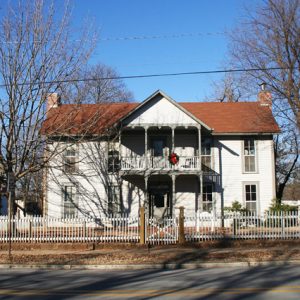calsfoundation@cals.org
Sarah Bird Northrup Ridge House
The Sarah Bird Northrup Ridge House is the oldest house still standing in Fayetteville (Washington County), dating back to 1836. Its original pine flooring and field stone fireplaces have endured to the present. It was built with the latest methods of the time, including mortised construction, shake shingles, and square-headed nails. The original cabin style was called “dog-trot” or “dog-run” and consisted of two single rooms separated by an open passage called a breezeway. A common roof covered the two rooms and the breezeway. In later years, the house was made into two stories and converted to “salt box” style, and the breezeway was converted into a central hallway. The Ridge House, at 230 West Center, is now owned and preserved by the Washington County Historical Society.
The house was originally built as a wedding present for Dr. M. H. Clark and his young bride. When Clark’s wife died, he sold the house to Joseph M. Sheppard in July 1839. In 1840, Sarah Bird Northrup Ridge bought the Fayetteville house and all the property with it from Sheppard for $1,375. Ridge and her children—Clarinda, John Rollin, Susan, Herman, Aeneas, Andrew Jackson, and Flora—had sought refuge in Fayetteville after they fled Indian Territory following the June 22, 1839, assassination of her Cherokee husband, John Ridge; his father, Major Ridge; and his cousin, Elias Boudinot. Many Cherokee were bitter at the role John Ridge had played in negotiating the Treaty of New Echota, which called for the removal of the Cherokee from their native lands in Georgia.
Sarah Ridge left Fayetteville during the fall of 1844 for Osage Prairie in Benton County to settle the accounts of her deceased husband’s estate, which consisted of nearly $50,000 worth of land and slaves; it also included his father’s estate. She had to protect the rights of her children as natives of the Cherokee Nation, but she avoided staying within the Cherokee Nation until the Treaty of Union was signed in 1846 because of the ever-present threat of ambush and murder. Ridge returned to Fayetteville in 1854, where she died of pneumonia two years later.
The remaining members of the Ridge family left the house after the death of Ridge’s son Aeneas in 1859, and in September 1859, the house and property were sold by Herman Ridge and Aeneas’s widow, Mavis, to Joseph Holcomb, son of Shiloh (now Springdale) founder John Holcombe. Holcomb married in 1860 and sold the house and part of the property to Dr. John Scarborough, and as soon as the Civil War began, the house and property were sold to the Tandy Kidd family. The Kidds lived at Jordan Creek near Cane Hill (Washington County), and Tandy Kidd had bought the house as a wedding present for his son William and his young wife, Mary. Tandy died in August 1862, and when the war ended, a member of the Kidd family petitioned to sell the house. This met with problems, however, because of an accumulated $10,000 debt that came with the house. This debt was ignored by the sheriff, and in 1867, J. R. Pettigrew and Judge David Walker purchased the house for only $750. Walker had once lived across the street from the house.
The house was sold again in 1873, and from 1873 until 1920, it was operated as a boarding house. When the Cory family purchased the house in 1920, they discovered the original log structure of the house beneath the remodeled parts.
The Ridge House was turned over to the Center Street Church of Christ in 1971, and in 1973, the Washington County Historical Society purchased it from them to be converted into a museum with living history tours. Its exhibits include artifacts retrieved from an archaeological dig conducted by the University of Arkansas (UA) in Fayetteville and portraits of the entire Ridge family. Today, it is used for professional offices, including offices for family counseling services and architects, and is on the National Register of Historic Places. The Ridge House is an unofficial Trail of Tears landmark commemorating the Cherokee Indians who were forced to leave their homelands and relocate to Indian Territory.
For additional information:
“Fayetteville’s Oldest Home?” Flashback 21 (August 1971): 39–55.
Poole, Arlen D. “Life of Sarah Bird Northrup Ridge.” Flashback 57 (Summer 2007): 49–66.
Poorman, Forrest. “230 West Center, Fayetteville, Arkansas.” Flashback 42 (February 1992): 12–17.
Washington County Historical Society. http://www.washcohistoricalsociety.org (accessed September 7, 2023).
Lonnie Strange
University of Arkansas, Fayetteville
 Sarah Bird Northrup Ridge
Sarah Bird Northrup Ridge  Sarah Bird Northrup Ridge House
Sarah Bird Northrup Ridge House 




I have examined the deed on record in the Washington County Archive between Clark and Sheppard for the sale of the Ridge House. It looks like Clark’s wife, Mary, was a signator on the deed, certified as appearing to the clerk for the sale, although accounts say that the sale was supposedly made following her death.
Walker sold his house across the street to Stephan K. Stone in 1850, according to the National Register documents.